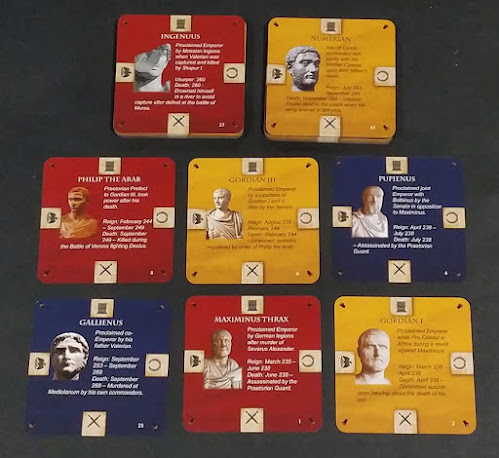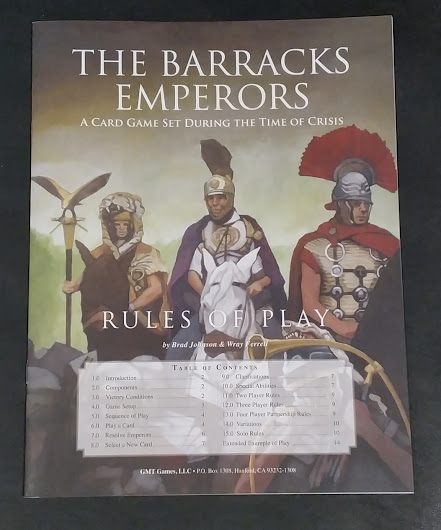The Barracks Emperors (GMT Games, 2023) is a
trick-taking card game, played on a grid-pattern board. No dice, few bells and
whistles; it’s driven by its own internal mechanisms around card placement rules
and the vagaries of the deck shuffle. Nonetheless, it is a very attractive
product, and a very intriguing game. It comes from the same designers who
brought us Time of Crisis: The Roman Empire in Turmoil, 235-284 AD (GMT
Games, 2017) and Sword of Rome (GMT, 2004). These folks know their
stuff.
 |
| Box back cover. |
While “merely” a card game, The Barracks Emperors is steeped in the events, personalities and culture of the period, and the way the game works mimics the byzantine politics and pulling of levers that drove the internal struggles of a failing, flailing empire in its last gasps.
The game is played out on
a standard 34” by 22” mounted board with a background map in muted tones of the Mediterranean Sea,
surrounded by southern Europe, North Africa and the Levant familiar to anyone who’s
played Time of Crisis. Overlaid is a grid of squares, some marked with wreaths,
some with crossed hand-axes, and some blank. These markings are mnemonic devices
for the placement of cards for the start of the game.
At the left-hand side of
the map are a series of other boxes marked for two of the card decks and for
the extracted Pretender emperors. To the right-hand side are spaces for the Influence
draw and discard decks and four spaces of ascending value under the heading of
FORUM. But I’m getting ahead of myself.
The rules are presented on
mid-weight (maybe 110-ish gsm) matt paper. The rulebook is sixteen paged long, and
one of those is the front cover. The rules are clear and informative, and richly
illustrated with explanations of components and examples of play. I had a solid
grasp of how the game functioned after a single read-through, which isn’t always
a given.
The actual rules run to
eight pages, including details for playing two- and three-player games. Four
pages are devoted to solo play, including a sample set-up (the solo set-up uses
the Roma card (pictured below), which is left out of play in the multi-player
games). In keeping with GMT's tradition of long standing, a pdf copy of the rules is available here.
 |
| Sample Emperors. Spend your influence wisely. |
There are three decks of cards in play in The Barracks Emperors. The Emperor cards are in three suits; Military (red), Senate (blue), and Populace (yellow). This theme will be familiar to anyone who has played Time of Crisis. A selection of Emperor cards is placed in the wreath-marked boxes on the board ahead of play, and again in the subsequent two rounds (I don’t want to turn this into a review or a how-to-play, but a rudimentary understanding of how things interact will be important).
2.jpg) |
| Sample Influence cards. |
The Influence cards are also divided into the same three suits, with numerical values running from one to eight. Each card also has a special ability that can affect its interaction with an Emperor or Emperors (depending on its position), or on other already-placed Influence cards. An explanation of each Influence cards’ special abilities is included in the rules.
 |
| Easy-punch, pre-rounded counters, big enough to read without glasses. |
The special ability of
some cards will give a +1 or +2 bonus to a pre-existing influence card of the
same suit elsewhere on the board; these bonuses are recorded by placing a token
on top of the affected card.
 |
| Barbarian card (centre), card back logo (left), and Roma card on its Fortified side. The Roma card is used in the solo game only. |
Seeded into the Influence draw deck are Barbarian cards. Each round of the game also begins with four Barbarian cards already placed on the board at the cardinal points. If you choose to play a Barbarian card, you discard that card, and move a Barbarian card already on the table to another free location. This is probably a good point to talk about orientation. Ideally in a four-player game, each player will sit at one side of the board. Each side has a symbol associated with it, representing that player’s faction.
.jpg) |
| PACs, each with its own faction symbol. These are replicated on the borders of the Emperor cards. |
The four factions are Wreath, Sword, Eagle, and Pillar, as demonstrated in the top-corner of the Player Aid Cards above. Yes, the PACs are actually cards, like those in the deck. This makes sense; everything you need to be reminded of fits on the two sides of the card.
.jpg) |
| PACs are double-sided. |
Cards
are always placed and played in the same orientation (top edge of all cards facing
north). When a player places an Influence card, they can only place a card on
their side of an Emperor. This may put their card against a different edge of
another Emperor, and that’s okay, so long as one edge is meeting an Emperor
legally. When an Emperor is surrounded, he is resolved, i.e. the faction with
the highest level of influence over that Emperor collects that card and puts it
in their prize pool (called a scoring area in the rules).
 |
| Influence suits and Barbarian deck (some Barbarian cards are incorporated into the Influence draw deck at the beginning of the game). |
Now,
let’s talk components. The game comes in a solid, 2-inch box that nearly all
GMT products come in these days. While I didn’t find the cover art particularly
inspiring, I don’t actually hate it. And you don’t play the cover.
.jpg) |
| The forum, populated. |
The board is also the high-quality print mounted on heavy card-stock for which GMT is so well-regarded. It looks nice; it’s probably not going to win any graphic design awards, but everything not specific to the players has a home on the board, which is something I’ve come to appreciate. While we’re on the board, I mentioned the Forum before. When you play an Influence card, you replace that card, but you don’t draw it from the deck; instead, you visit the Forum. And this is the bit I really like. The four boxes are marked 8 or less, 6 or less, 4 or less and 2 or less, and the selection of cards is arranged from lowest to highest value. The card you last played will dictate your choice of cards. If you played a 1- or 2-value card, you can choose from any of the four cards displayed. If you played a 7 or an 8, you are limited to the lowest-value card in the Forum. It’s a little thing, but brings a lot to the table in terms of balance, and adds another lever to the strategic options of the game.
 |
| Initial set up for a four player game. |
The
cards are all printed from the same stock, which will be familiar to anyone who
has bought a Card-Driven or Card-Assisted game from the publisher. The cards
are square, but they are a standard size used in some Euro games, so sleeves
should be easy enough to come by. And you will want to sleeve these; thy are
going to get a lot of use.
.jpg) |
| Emperors awaiting their turn in the big chair. |
Materially, there isn’t much to The Barracks Emperors, but that’s no reflection on the game. This should be reflected in the price when it reaches antipodean shores. The components are all good quality, though, as I mentioned earlier, you will probably want to sleeve the cards (at least the Influence and Barbarian cards) as they are the workhorse of the game.
 |
| Emperors are resolved when they are surrounded on all four sides. The placement of the Red 3 influence card will cause both Gordian III and Probus to be resolved. |
Everything you need to play is here.
If I had one gripe, it would be that an extra four pages to the rulebook with a
historical context essay and some design notes would have been nice, but I’m a
bit of a prat that way. I think I've just been spoilt by games like Fire and Stone: Siege of Vienna. This absence is mitigated somewhat by the little bio-notes on each of the emperor's cards (spoiler alert: it doesn't end well for any of them).
* Normally I would reserve a Stripped
Down for Parts piece for more visually stunning games (like Task Force),
or ones with a lot more going on (expect something in the future on Mr
President), but I did this on request DL on the Adelaide Board Wargamers
group on Facebook. I didn’t do this instead of a full review – that will come after
I’ve had the chance to play The Barracks Emperors a couple of times. Thanks for
reading all the way through.



.jpg)





No comments:
Post a Comment